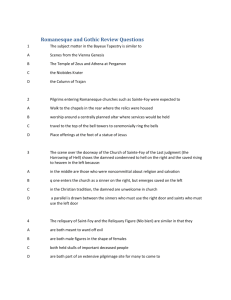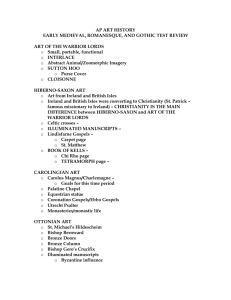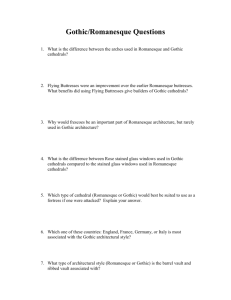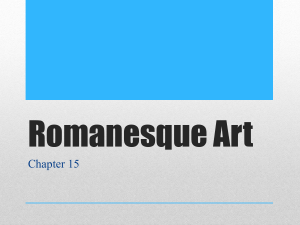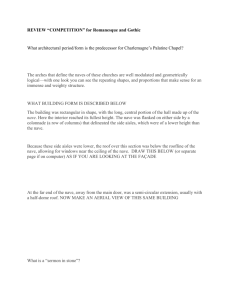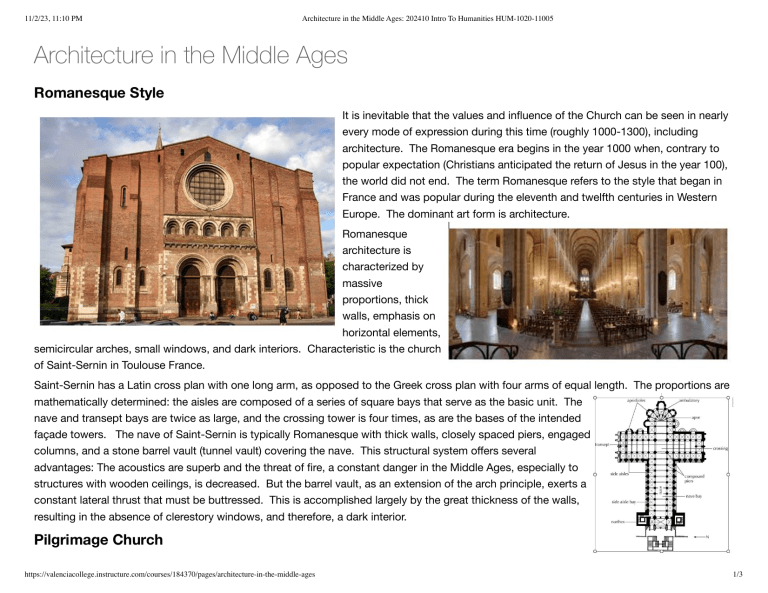
11/2/23, 11:10 PM Architecture in the Middle Ages: 202410 Intro To Humanities HUM-1020-11005 Architecture in the Middle Ages Romanesque Style It is inevitable that the values and influence of the Church can be seen in nearly every mode of expression during this time (roughly 1000-1300), including architecture. The Romanesque era begins in the year 1000 when, contrary to popular expectation (Christians anticipated the return of Jesus in the year 100), the world did not end. The term Romanesque refers to the style that began in France and was popular during the eleventh and twelfth centuries in Western Europe. The dominant art form is architecture. Romanesque architecture is characterized by massive proportions, thick walls, emphasis on horizontal elements, semicircular arches, small windows, and dark interiors. Characteristic is the church of Saint-Sernin in Toulouse France. Saint-Sernin has a Latin cross plan with one long arm, as opposed to the Greek cross plan with four arms of equal length. The proportions are mathematically determined: the aisles are composed of a series of square bays that serve as the basic unit. The nave and transept bays are twice as large, and the crossing tower is four times, as are the bases of the intended façade towers. The nave of Saint-Sernin is typically Romanesque with thick walls, closely spaced piers, engaged columns, and a stone barrel vault (tunnel vault) covering the nave. This structural system offers several advantages: The acoustics are superb and the threat of fire, a constant danger in the Middle Ages, especially to structures with wooden ceilings, is decreased. But the barrel vault, as an extension of the arch principle, exerts a constant lateral thrust that must be buttressed. This is accomplished largely by the great thickness of the walls, resulting in the absence of clerestory windows, and therefore, a dark interior. Pilgrimage Church https://valenciacollege.instructure.com/courses/184370/pages/architecture-in-the-middle-ages 1/3 11/2/23, 11:10 PM Architecture in the Middle Ages: 202410 Intro To Humanities HUM-1020-11005 When the expected events of the year 1000 did not happen, church constructions got underway. Many of these new churches housed relics (sacred objects of veneration) and attracted pilgrims as a result. Pilgrims traveling to these churches seeking healing from the relics, atonement for sins, or simply traveled to pay homage to a particular saint. Saint Sernin is also an example of a “pilgrimage church”, located on one of the roads leading to the pilgrims’ goal, the church of Santiago de Compostela (Saint James of Compostela) in north-western Spain. Santiago (Saint James) brought Christianity to Spain and was martyred upon his return to Judea. His body was miraculously recovered and buried at Compostela, where repeated miracles made his shrine a major pilgrimage center. Pilgrimage churches along the route to Santiago de Compostela, therefore, had to be large to accommodate the large numbers of pilgrims making their way. Gothic Architecture This is an example of a rose No city dominated the later Middle Ages more than Paris, the center of a revival of learning at the newly founded university. Paris was also the seat of the French government under King Louis IX, later St. Louis, who made a determined effort to be a king to all window. his people. The Gothic architectural style started with a church remodel in Paris. The abbot who designed the church kept the cross-shaped floor plan of earlier Christian churches, but also wanted to emphasize light, which is "brilliant but immaterial" so that the lighting itself would be an analogy to God. Light also symbolized the deep mysteries of medieval Christianity. Thus, he installed stained glass windows. Stained glass windows often featured scenes from the Bible. This served two functions: first, it was another way to incorporate the important figures and symbols into the church experience; second, it helped a largely illiterate congregation learn the stories central to its faith. It is common to see Mary, the mother of Jesus, featured, as well as scenes from the Passion (final days) of Jesus as the Christ. Color is also important in stained glass windows, symbolizing purity (blue) and sacrifice (red). An unexpected consequence of incorporating so many windows is that they could not support the weight of the roof as did the masonry slabs that they replaced. Thus, new architectural features were required to redistribute weight and support taller buildings. All throughout the Gothic age, churches reflected the religious fervor, as well as power, of Christianity - a testament to how religion can be a powerful motivator for the arts, and especially architecture. https://valenciacollege.instructure.com/courses/184370/pages/architecture-in-the-middle-ages 2/3 11/2/23, 11:10 PM Architecture in the Middle Ages: 202410 Intro To Humanities HUM-1020-11005 This is a stained glass window featuring the Virgin Mary and This image visualizes the features of Gothic architecture Jesus. https://valenciacollege.instructure.com/courses/184370/pages/architecture-in-the-middle-ages 3/3


